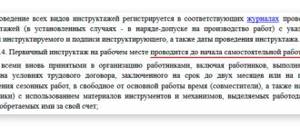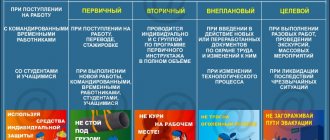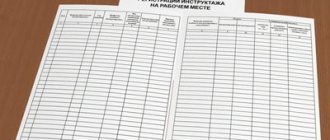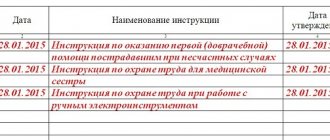Repeated training in the workplace - what is it?
Repeated briefing at the workplace is one of the 5 types of mandatory safety briefings (HS), provided for by Decree of the Ministry of Labor and Ministry of Education of the Russian Federation dated January 13, 2003 No. 1/29 (hereinafter referred to as the Training Procedure).
Briefing is a way of briefly informing employees about hazardous production factors, general rules for providing first aid and practical skills that must be possessed in order not to cause harm to life and health during work.
Repeated briefing is intended to maintain and update knowledge on TB acquired during other types of training, therefore, unlike other types of briefing (introductory, targeted, unscheduled and primary), it is carried out on a regular basis.
ConsultantPlus experts explained in detail how to organize labor protection at an enterprise. Get free demo access to K+ and go to the HR Guide to find out all the details of this procedure.
Types of instruction
There are 5 types of instructions in total, they are divided into:
| Type of instruction | Who conducts | Purpose of the event |
| Introductory | The instruction is carried out by a labor protection specialist or an authorized employee. The appointment of the person responsible for instructing workers can be secured by an administrative document, and the instructing person must be certified in occupational safety and health (OHS) | Before entering the enterprise, the employee must listen to a lecture on occupational safety. The material issued takes into account the nuances of being on the territory, possible dangers, the basics of fire safety, first aid, actions in the event of emergencies or incidents. |
| Primary | This type of briefing is carried out by the immediate supervisor to the new employee before the latter starts work. In this case, the conductor must have an occupational health and safety (HS) certificate. | The newcomer, despite having undergone training, must be familiarized with the workplace and the possible dangers of the new job. He is informed of the working hours regulations, at what time lunch or rest breaks are set, as well as possible dangers in the work area. |
| Repeated | Conducted by immediate supervisor | The material of the initial briefing is repeated |
| Unscheduled | Instruction of employees is assigned to the immediate supervisor | This type of instruction is carried out in the following cases:
|
| Target | The manager instructs the workers | If an employee is sent to perform a task that is unusual for his job description or to perform dangerous work, then he must be instructed in accordance with the current instructions, and it should be taken into account that the performance of dangerous tasks requires the presence of a certificate |
Instructions are mandatory and regulated by GOST.
On-the-job refresher training program
All TB trainings are carried out according to special programs.
Retraining programs are developed by heads of departments (shops, sections, departments). After agreement with the persons or structures responsible for labor protection, they are approved and put into effect by order of the enterprise. When developing the program, legislative acts, instructions, industry standards, and technical working documentation are taken as a basis.
The main issues that should be covered are contained in GOST 12.0.004-90 “Organization of occupational safety training.”
The retraining program must be structured in such a way that the following information is communicated to the employee during the training process:
- general information about the production process and the equipment to be used;
- list of factors harmful to health;
- rules for safe stay and movement on the territory of the enterprise;
- rules for preparing equipment and inventory;
- information about hazardous areas near equipment and machinery;
- information about available automatic protection systems (such as blocking, alarms, braking), personal protective equipment, rules for their use;
- rules of behavior in dangerous situations;
- statistics and analysis of industrial accidents.
You will learn what harmful factors there are in production from the article “Dangerous and harmful production factors (list).”
How to document
The process of completing the briefing
To confirm the fact of repeated briefing, entries are made in special journals. It is recommended to organize this process correctly as follows:
- An enterprise or organization must develop a regulatory document that reflects the form of the occupational safety journal, the procedure for filling it out, and who should maintain the documentation. Usually this is an Enterprise standard or Regulation developed by the labor protection service.
- The form for filling out the occupational safety journal should consist of several columns, the contents of which indicate the following: a list of occupational safety instructions with numbers, the date of the briefings, columns for the signatures of the instructor and the instructee.
- After the briefing, the manager must check where the employee signed, and the date must be put next to the signature, otherwise it will be difficult to prove that the briefing was carried out on time.
The training log must be located at the work site.
What is the frequency of refresher training at the workplace?
Repeated training at the workplace is carried out no less than 6 months after the employee has completed the initial training and started work.
In the future, this type of training must be repeated every six months. This is a general rule. The employer does not have the right to arbitrarily increase the time interval between briefings. This is possible only in agreement with the trade union organization or federal and regional bodies that control labor protection issues (clause 7.3.1 GOST 12.0.004-90). A smaller interval is allowed.
For workers employed in complex and hazardous industries, industry rules establish a standard of not six months, but 3 months.
Who should undergo refresher training?
Repeated instruction is necessary for those who have completed the initial instruction (clause 2.1.5 of the Training Procedure).
These are newly hired (under fixed-term and open-ended employment contracts) employees, part-time workers, seasonal workers, secondees, student interns, persons hired to work from other organizations, as well as those transferred within the enterprise from one site to another. In general, everyone who participates in the production process works on machines, mechanisms, electrical equipment or deals with raw materials.
Do all employees need to undergo refresher training?
According to clause 2.1.4 of the Training Procedure, employees who do not have to use equipment, electrical and other tools, raw materials, materials, or store them in the course of their work may not undergo initial and repeated briefing.
For the exemption to be legal, the employer must by order approve the preferential list of professions and positions.
This paragraph of the Training Procedure raises the most questions due to the inaccuracy of the wording.
In particular, it is not clear whether it is possible not to conduct periodic briefings for office employees.
The Ministry of Labor of the Russian Federation, answering this question (letter dated March 24, 2015 No. 15-2/OOG-1551), indicated that those who deal exclusively with office equipment may not undergo initial and repeated training.
And then a link is given to clause 2.1 of GOST 12.0.004-90 “System of Occupational Safety Standards”, which says that the employer needs to coordinate the list of exempt people with the trade union organization and the safety service. At the same time, the Training Procedure (clause 2.1.4) does not contain any requirements for approval.
Important! In conditions of legal uncertainty, the employer should understand that by signing an order to exempt employees from undergoing periodic training and being a guarantor of safe work, he signs his full confidence that this workplace cannot pose any threat to life and health.
If an accident occurs at work with one of the office staff, the blame will fall entirely on the employer.
The manager and the organization itself will have to not only pay a fine, but also compensate for moral and material damage to the victim. The head of the enterprise will pay a fine from 15,000 to 25,000 rubles, the organization, as a legal entity, will lose from 110,000 to 130,000 rubles. (Article 5.27 of the Code of Administrative Offenses of the Russian Federation).
Repeated training on labor protection
ANO DPO "CPR Profi" provides training in the following areas:
Occupational safety specialist.
Diploma. Advanced training: Occupational safety
Work at height
electrical safety
Who should be retrained with?
Repeated training on labor protection is carried out with the same employees who have already completed the initial training. According to clause 8.8 of GOST 12.0.004-2015, which comes into force on March 1, 2017, repeated training is carried out in the same way as initial training in the workplace in order to consolidate the knowledge and skills already acquired by employees.
Persons with whom it is necessary to conduct initial and repeated (periodic) briefings are listed in clause 8.7 of GOST 12.0.004-2015. These include:
- all persons hired, including for short-term, seasonal and other temporary work. These also include part-time workers and homeworkers (if they use materials, tools and mechanisms provided by the employer);
- employees who were transferred
- employees who have been assigned to perform work that is new to them;
- personnel of contractors (subcontractors) who perform work on the territory and facilities controlled by the training organizer;
Let us remind you that the employer can, by order, approve a list of professions or specialties for which it is not necessary to conduct initial and repeated briefings at the workplace. This applies to those employees who are not involved in the operation, maintenance, testing, adjustment and repair of equipment, the use of electrical equipment and are not engaged in work with increased danger.
What programs or instructions require refresher training?
Repeated briefing is carried out according to the same programs and instructions as the initial briefing at the workplace. They are developed by the head of the structural unit and agreed upon with a labor protection specialist. After which the programs and instructions are approved by the employer of the enterprise.
To draw up the necessary programs and instructions for briefings in the workplace, you can use the sample program from Appendix B of GOST 12.0.004-2015, labor protection instructions for the necessary professions and types of work performed, approved at the enterprise, rules and instructions for the safe operation of equipment a also GOSTs, SanPiNs, hygiene standards, safety standards, etc.
| HEALTHY The initial training program at the workplace may include the following questions: 1. General information about the employee’s working conditions: the technological process, equipment and production environment at the employee’s workplace, the nature of his work process (tension and severity):
2. Procedure for preparing for work:
3. Scheme for the safe movement of an employee within the territory of a unit or organization:
4. Emergency situations that may arise in the workplace:
5. Familiarization with all instructions on the workplace and labor protection by profession (in accordance with the list of professions developed by the employer for each workplace, indicating the numbers of instructions required for instruction). |
During repeated briefing, the employee is reminded of the labor protection rules for the given specialty and workplace, and is again told about the technical aspects related to the work process. In addition, it is imperative to consider recent industrial accidents, their causes and ways to prevent them from happening again. It is no secret that if an employer is negligent in its duties and does not draw conclusions after industrial accidents, they will certainly occur again.
EXAMPLE: Last year, two serious incidents occurred at one of the confectionery factories in just one week. First, the employee's hand was pulled into the rotating mechanism of the machine, as a result of which she received a traumatic amputation, fractured ribs and lower jaw. A few days later, a mechanic who was repairing equipment suffered a serious hand injury. During an unscheduled inspection, GIT inspectors discovered many violations at the factory. It turned out that the machine on which the injuries were sustained does not have a protective mechanism.
Who should conduct refresher training and how often?
Repeated instruction at the workplace is carried out by the immediate supervisor of the work. This could be a shift or site foreman, foreman, department head, etc. The main thing is that the employee who conducts the briefing himself undergoes training in labor protection and testing of knowledge of labor protection requirements in accordance with the established procedure (Resolution of the Ministry of Labor of Russia, Ministry of Education of Russia dated January 13, 2003 No. 1/29 “On approval of the Procedure for training in labor protection and testing knowledge of labor protection requirements for employees of organizations").
Repeated training can be carried out:
- individually with each employee;
- or with a group of people who operate the same equipment in a common workplace.
Repeated briefing must be carried out at least once every six months for all employees who have undergone initial briefing (clause 2.1.5 of the Resolution of the Ministry of Labor of Russia, Ministry of Education of Russia dated January 13, 2003 No. 1/29).
But there are categories of workers for whom repeated training is carried out at least once every three months. These include employees who are involved in high-risk work, all electrical personnel, and others specified in industry regulations.
EXAMPLE: In paragraph 9 of the Order of the Ministry of Labor of Russia dated June 23, 2021 No. 310n “On approval of labor protection rules during the placement, installation, maintenance and repair of technological equipment” there is an indication that employees who are engaged in work related to the placement , installation, maintenance and repair of stationary machines, mechanisms, devices, instruments and other equipment used in the production of industrial products must undergo repeated training on labor protection at least once every three months.
In addition, the employer himself, if he sees a need, can change the frequency of repeated training for employees, but only more than once every six months. He can fix the new periodicity by his order.
After an employee has undergone regular on-the-job training, he must be tested on his acquired knowledge. Unlike a knowledge test, where an employee responds to tickets in writing, after OT training, the acquired recurrent briefing material is tested only orally. The manager asks the employee questions about safe work practices, asks him to demonstrate how to work safely with tools and equipment at a specific workplace, tell him what personal protective equipment he must use while working, etc. If the inspector is convinced that the employee has mastered the material, he makes an entry about this in the briefing log. It must indicate the date of the repeated briefing, and put the signatures of the person being instructed and the person instructing.
What threatens the employer if he does not conduct repeated training?
Employers sometimes commit many gross violations when conducting briefings and filling out the required logs. Here are just a few of them:
- The employer does not have the right to allow employees to work if they have not completed all required training, including repeated training at the workplace. Some managers conduct training nominally, allowing employees to sign logs. It would seem that, when checking, the GIT inspector will see the presence of a journal and paintings in it and will not notice the forgery. In practice, inspectors are well acquainted with such tricks of employers. Therefore, they can selectively interview employees whose names are listed in the on-the-job training log. And he will find out what instructions and topics the knowledge test was carried out on. If an employee is unable to answer the inspector’s questions, the inspector will consider that the employer is not providing instructions to employees and will fine him a serious amount. In addition, it will force you to re-instruct employees.
- The employer violated the date of re-training. For example, an employee of an enterprise belongs to electrical technical personnel (electric welder). It is necessary to carry out repeated instructions with him at least once every three months. If, during the inspection, the inspector requested logs of briefings and found out that this employee was given an initial briefing on February 5, and a second briefing not until May 5 (as expected), but on August 5, then this fact will constitute a serious violation for the labor inspector, for which punishment.
The employer must remember that if he does not provide instructions to at least one of his employees, he faces a fine of 110,000 to 130,000 rubles (for each employee!). This punishment is enshrined in Part 3 of Art. 5.27.1 Code of Administrative Offences.
| BRIEFLY Stages of repeated training on labor protection at the enterprise: Stage 1 – determine who is conducting the refresher briefing Repeated briefing, like the initial briefing, is carried out by the employee’s immediate supervisor - foreman, foreman, shift supervisor, who has undergone training in labor protection and testing of knowledge of labor protection requirements. Stage 2 – develop and approve a program for repeated training on labor protection Repeated instruction is carried out according to the same programs and instructions as the initial one. Let us remind you that programs and instructions for initial training are developed by the employee’s immediate supervisor with the methodological support of a labor protection specialist. The document is based on legislative and other regulatory legal acts. The program must take into account the specifics of the organization’s activities. An approximate list of questions for the initial briefing program is given in Appendix B to GOST 12.0.004-2015. Stage 3 – identify employees who need to be retrained Repeated training is carried out with the same employees as the initial one. Namely:
Stage 4 – re-instruct and test your knowledge Repeated training at the workplace must be carried out according to the program approved by the enterprise at least once every six months. In some production facilities – at least once every 3 months. This frequency is specified in industry regulations. Also, the employer himself, in his local act, can approve a more frequent frequency of repeated briefings than determined by law. After the employee has been re-instructed, it is necessary to verbally check the knowledge he has acquired. Stage 5 – make a record of the repeated briefing After repeated briefing at the workplace, you need to make an entry in the logbook for registering the briefing at the workplace. Indicate the date of the event in the journal and affix the signatures of the person being instructed and the person instructing. |
Read:
Occupational safety briefings
Initial briefing on labor protection
Unscheduled briefing on labor protection
Targeted training on labor protection
Source: https://www.trudohrana.ru
Who is entrusted with conducting repeated training at the workplace?
Who should carry out the briefing - personally to the head of the enterprise (individual entrepreneur), heads of workshops, sections, foremen, assigned employees or attracted teachers and specialists, depends on the number of employees.
Important! A mandatory requirement for instructors is to undergo appropriate training and knowledge testing in specialized educational centers.
At enterprises with more than 50 employees, a separate specialist must be appointed or an independent labor protection unit must be organized (Article 217 of the Labor Code of the Russian Federation). The responsibilities of the specialist or unit will include organizing any safety training.
In organizations with a smaller workforce (up to 50 people), the manager can deal with safety issues personally (if he considers it appropriate), he can entrust them to one of the employees, organize an appropriate department or enter into an agreement with an accredited organization that will oversee labor safety issues, including re-training.
The manager must issue an order assigning responsibilities for conducting repeated and initial briefings to specific individuals.
What is the purpose of repeated instruction?
Training is about providing information and testing the skills and knowledge needed to work safely and avoid traumatic situations. If a person demonstrates an unsatisfactory result during testing, he is not allowed to work independently until he has been instructed again. In this case, an order is issued to temporarily remove the person from work. The relevant information is noted in the registration log. Marks can also be entered into the personal card of the person being checked.
Safety briefing
Repeated training on labor protection is carried out:
- individually;
- with a group of people;
- within the general workplace.
Re-training should be carried out at least once every six months. All employees who have undergone initial training are required to undergo it.
For your information! Information should be accompanied by demonstration of safe techniques and methods available for use when performing job duties.
If repeated instructions on labor protection are ignored and the frequency is not met, in this case penalties will be imposed on the company by the inspection structures. Fortunately, from a bureaucratic point of view, the process is organized without problems. Thus, for repeated briefing, the same programs and documents are used as for the initial briefing, so its implementation does not take much effort.
Occupational safety briefing
It is recommended that the document include:
- general information informing about working conditions. These include data on the production environment, equipment used, technological and labor processes;
- preparation procedure. It includes methods and techniques, requirements for special clothing, checking the serviceability of protective equipment and equipment;
- a scheme for safe movement around the territory;
- instructions on occupational health and safety at the workplace;
- emergency situations that could potentially arise.
Refresher training for remote workers and homeworkers
Telecommuters, like all others, must be trained in workplace safety procedures. It is the employer’s responsibility to conduct initial training before allowing such an employee to work. This means that he is required to undergo repeated training every 6 months.
In this case, the Labor Code of the Russian Federation allows for a remote method of repeated instructions (Part 6 of Article 312.1). You can confirm completion of the training by exchanging electronic documents.
With regard to homeworkers, the requirement to undergo regular six-month training is also fair, since homework is permitted only if labor safety requirements are met (Article 311 of the Labor Code of the Russian Federation). Since repeated instruction is carried out at the workplace, a specialist instructor must travel to the homeworker’s place of work.
Instructions for implementation
The rules for implementing periodic instructions to staff are as follows:
- The story plan for repeated instructions is exactly the same as for the primary one.
- Performed with a group of employees or individually.
- who first came to the place of permanent or temporary work must listen to the program again This also applies to personnel of another enterprise who take part in the labor process.
- Frames that are not related to installation are exempt . The full list of people who are allowed to evade participation in the procedure is approved by management.
- The person responsible for carrying out the procedure at the end of the meeting must ensure that all workers have thoroughly understood the safety rules and regulations . For this purpose, the method of oral questioning or testing knowledge using high-tech means is usually used.
- If an employee fails the final knowledge test, he is temporarily suspended from his duties based on the order of the manager. The person responsible for the procedure reports the failure in a memo. The frame returns to work only after successfully passing testing. During absence from work, the employee is not paid wages .
Respirators and gas masks were developed specifically to protect the respiratory system when working in hazardous environments.
Read the following articles for more information. Find out in what areas of activity safety helmets are used here.
Conducting refresher training for contractors
The regulatory documents do not define who should conduct repeated training for the employees of the contracting organization involved - the customer or the contractor. Employees of involved organizations are mentioned only in cases related to induction training (clause 2.1.2 of the Training Procedure).
The conclusion suggests itself that in relation to the attracted workforce, the customer organization is only subject to the obligation to conduct induction training.
The remaining types of training must be carried out by the contracting organization with its employees.
Since the contractor carries out work on the customer’s territory, the latter is obliged to monitor compliance with safety standards at its own site, including repeated training for employees of the contracted organization.
Oral check and log book
Employees should not only be passive listeners, but also undergo an oral test of acquired knowledge after each briefing. Those who showed unsatisfactory results are not allowed to work and are required to undergo instructions and testing again (clause 7.8 of GOST 12.0.004-90).
Data on the briefing must be recorded in the registration log (Appendices 4 and 6 to GOST 12.0.004-90) with the signatures of those who conducted the briefing and who listened to it.
Employees who did not undergo training on time, regardless of whether this happened for a good reason (being on sick leave) or not, cannot be allowed to work.
Who conducts
Repeated training is carried out by an employee or an external specialist who has undergone appropriate training in occupational safety. If we are talking about a company representing a small and medium-sized business, employees are usually instructed by the manager himself or one of his deputies.
Large companies form special units of specialists who monitor compliance with labor safety standards and conduct periodic briefings. It is also permissible to engage third-party specialists for this purpose under a contract. The order for repeated briefing must indicate the persons responsible for its conduct. They are also responsible for the timely preparation of the recurrent briefing log. Its implementation is confirmed by the signatures of workers and occupational safety specialists. The recommended form of the journal is contained in the appendix to GOST 12.0.004-90.
Training for managers and specialists
Managers of enterprises and specialists in occupational safety and health are not instructed, but trained (part 2 of article 225 of the Labor Code of the Russian Federation, clause 1.5 of the Training Procedure). This more in-depth, compared to briefing, method of acquiring knowledge is mandatory for those who are responsible for safety at the entrusted enterprise and who themselves will train ordinary employees (part 2 of article 225 of the Labor Code of the Russian Federation, clause 1.5 of the Training Procedure).
Once employed, directors of enterprises, specialists and heads of safety departments must undergo training at an accredited training organization. They were given 1 month for this. Subsequently, retraining is required every 3 years.
An exception is made for occupational safety teachers with 5 years or more of continuous work experience, safety engineers and representatives of supervisory authorities at the federal and regional levels.
These categories of specialists can undergo training for the first time after employment not 1 month, but 1 year (clause 1.6 of the Training Procedure). They are required to undergo further regular training every 3 years.
Order of conduct
Sequence of occupational safety briefings
Repeated training is carried out in the following sequence:
- The manager prepares information from labor safety instructions; it is recommended to pre-compile a list of the latter (the materials can be noted down) and gathers workers in a classroom or other office.
- Then there is a lecture. If questions arise, additional explanations are provided.
- The manager conducts a short survey of employees about their mastery of the material.
- The repeated briefing is recorded in the Logbook against signature.
Results
Repeated training in the workplace is an opportunity to maintain and update knowledge of safe work rules.
Almost all employees must undergo it at least 2 times a year. The employer is obliged to organize the process, and employees are obliged to undergo training, acquire knowledge and apply it in practice. You can find more complete information on the topic in ConsultantPlus. Free trial access to the system for 2 days.
How often is refresher training carried out?
Repeated fire safety training: frequency
There is no universal solution here. The law stipulates that the employee must be informed about the state of affairs at least once every six months. The minimum period within which information must be provided is not regulated.
Note! If within the scope of work there is a high risk of injury and undesirable consequences for health or life, information and skills testing can be carried out each time before performing job duties.
This is reflected in the regulatory requirements. Thus, a worker working with high-risk equipment is required to undergo repeated training at least once every three months.
Safety Information
However, it is also possible to increase the agreed terms. The legislation provides that organizations, subject to agreement with local government supervisory authorities and trade union committees, may increase the periodic period for repeated training to one year. This opportunity exists only for certain categories of employees. So, if an ordinary office employee works with non-hazardous equipment or papers, then comparing him with a firefighter in terms of the level of danger he is exposed to is stupid.
Important! Failure to comply with established standards is punishable by penalties from government supervisory authorities.







